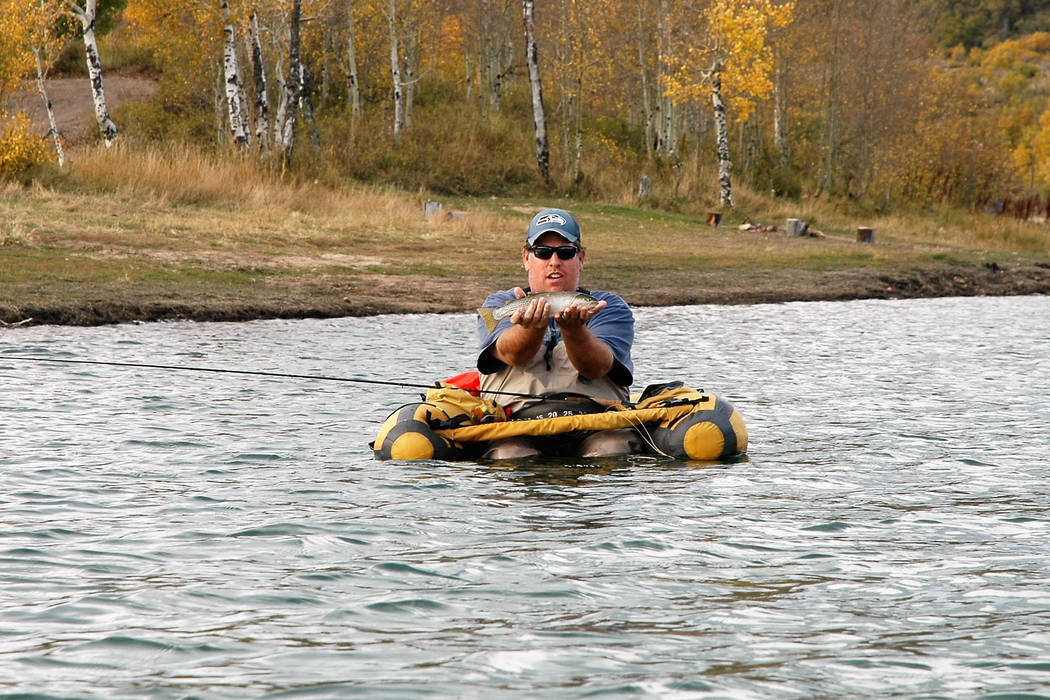Illegal stocking causes trout havoc at Utah reservoir

Late one hazy summer afternoon at Utah’s Kolob Reservoir, the blue-ribbon trout fishery suddenly came alive with activity where it had been completely still moments before. And most of the day for that matter.
Regardless of the direction one looked, fish were actively feeding at the surface. But it wasn’t the telltale dimples of a rising trout that anglers saw. Instead it was the massive heads of large trout for which Kolob has a well-earned reputation. Or perhaps I should say had.
The trout fishery many southern Nevada anglers have enjoyed through the years is gone. For the time being anyway. In fact, you won’t even find it listed on the Utah Division of Wildlife Resources digital fishing planner.
It seems that at least one person didn’t find rod-bending action for trophy-quality trout all that enjoyable. So, somewhere along the line they made the unilateral decision to change up the fishery’s main ingredients by planting additional — but not necessarily desired — fish species.
In 2018, DWR fisheries biologists discovered three illegally planted fish species in the waters of Kolob – bluegill, green sunfish and yellow perch.
“All three species pose a threat to the fish that already live in Kolob, particularly the wild trout,” said the DWR in an October 2018 news release. “The illegally stocked fish will compete with trout for food, which will reduce the growth rate of the trout, leading to smaller fish for anglers to catch. The overall number of trout in the lake will also decrease as the illegally stocked fish prey on younger trout.”
Moreover, these predatory species also represented a significant threat to endangered native fishes of the Virgin River downstream from the reservoir. They had to be removed, but there is no way to remove only the three species of concern while leaving behind the trophy trout anglers travel long distances to pursue. Ultimately, to save Kolob’s fishery, biologists had to kill all the fish. Trout too.
That meant using rotenone, a naturally occurring substance that prevents fish from processing oxygen through their gills. And that meant draining the reservoir to a level low enough to make the rotenone effective.
Prior to treating the reservoir, the DWR lifted all size and bait restrictions, and increased the bag and possession limits so anglers could remove as many of the fish as possible. However, those changes expired Nov. 1.
Biologists hoped to survey the reservoir in mid-April, but so far, they have been unable to access the reservoir. When they do reach the reservoir, biologists hope to find no fish, as in zero.
“If they don’t catch any fish, it means the treatment was effective, and they can begin restocking the reservoir with trout. Soon after the survey is complete, restocking will begin,” said the DWR in an April media advisory.
Richard Hepworth, Southern Region Aquatics Manager for the DWR, said the agency’s plans call for the stocking of three trout species — rainbow, cutthroat and tiger trout — as soon as possible. While those fish plants will provide angling opportunity right away, it will take about two years for the trophy side of the fishery to recover, Hepworth said.
That means many of us will need to be patient and enjoy the fishing opportunities for what they are. The large fish will one day return, but it will take a couple of seasons for the fish to reach the size to which we are accustomed.
Going forward, slot limits and bait restrictions will remain the same as before restoration efforts began.
In the meantime, there is an unclaimed reward of $3,000 for information leading to the prosecution of those responsible for illegally introducing the bluegill, green sunfish and yellow perch into Kolob Reservoir. If you have such information, you can call the UTiP hotline at 1-800-662-3337.
If you have never fished Kolob, you are missing out. It is a challenging and unpredictable fishery, but worth spending the time to learn. Weekend crowds can be a bit obnoxious, however, mid-week excursions are generally worth the drive. The reservoir is located north of Zion National Park at an elevation of about 8,100 feet. Camping is available but primitive.
Fraternity banquet
The Fraternity of the Desert Bighorn Sheep fundraising banquet will be May 18 at the South Point. Go to desertbighorn.com for more information.
Freelance writer Doug Nielsen is a conservation educator for the Nevada Department of Wildlife. His “In the Outdoors” column, published Thursday in the Las Vegas Review-Journal, is not affiliated with or endorsed by the NDOW. Any opinions are his own. Find him on Facebook at @dougwritesoutdoors. He can be reached at intheoutdoorslv@gmail.com.